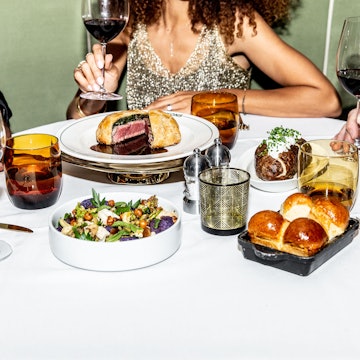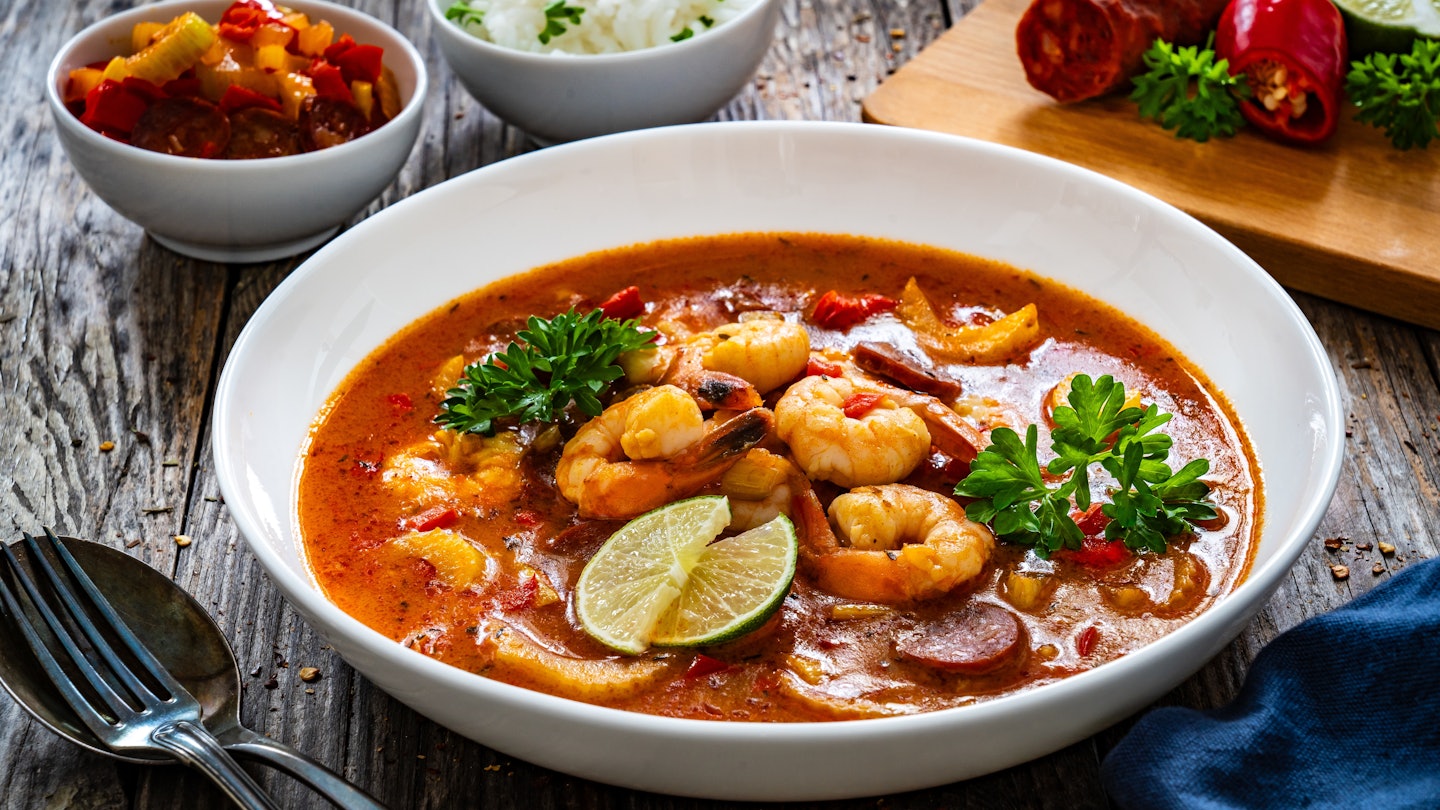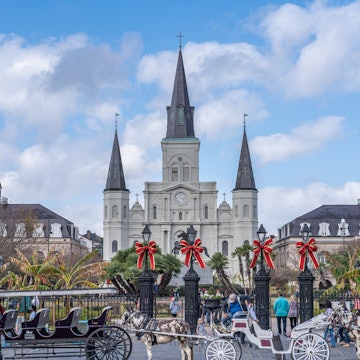

Louisiana gumbo. Jacek Chabraszewski/Shutterstock
Every state in the US is proud of its homegrown cuisine, but not every state can back its bragging with real evidence of culinary prowess. Louisiana can. The food culture here is iconic. Perhaps no other American state can boast a cuisine as well-known as Louisiana’s. In the 1980s, Cajun culture became a point of obsession around the world thanks to famous chefs like Paul Prudhomme, whose legacy has since been carried on by cooks such as Emeril Lagasse and Donald Link.
The Bayou state is a product of multiple cultural threads, including the African diaspora, Native Americans, French-Iberian Creoles, Acadians (Cajuns), and waves of settlers from Ireland, Germany, Vietnam and Honduras (to name a few). A culture developed here that elevated both the enjoyment of food and the indigenous products of Louisiana’s muddy terroir, from the prairies to the bayous to the Gulf of Mexico.

The ground rules
To begin, it’s important to note that Cajun and Creole are not interchangeable terms. The Cajuns are the descendants of Acadians (French Canadians) who settled in Louisiana’s prairies and bayous. Cajun cuisine is more rustic and arguably less complex (which is not to say either is better) than Creole cuisine, which derives from the French-Iberian demographic that settled in New Orleans. Their cuisines are different, although both tend to share a love of rich flavors, colorful presentation, and generous helpings of butter and fresh seafood.
You may also be wondering, what is roux? Roux (pronounced roo) isn’t a dish per se; it’s a simple base of flour and fat (usually oil or butter), used to thicken the base of a soup or sauce. There isn’t any one restaurant in Louisiana that does roux better than others; it is simply the base of any good local dish, often sold in jars at local convenience stores.
Crawfish
The humble crawfish is served one million ways across Louisiana: in pies, as étouffée (a stew served over rice), over french fries – the list goes on. But there’s one preparation you can't miss. A Louisiana crawfish boil is something special: a mini-festival of sorts that unites friends and family over good music, beer, and of course, tables of fresh-boiled crawfish. While the best boils tend to take place in someone’s backyard, you can’t go wrong finding crawfish in Breaux Bridge, the self-proclaimed crawfish capital of the world, which hosts its annual crawfish festival in May.
Outside of New Orleans in the town of Gretna, you’ll find an excellent new frontier in Louisiana cooking: Vietnamese-style crawfish. Confusingly, these shellfish are sometimes called "Cali style" crawfish, but whatever the nomenclature, they are a product of Vietnamese foodways, such as a love of melted garlic butter, combined with a classic Cajun Louisiana boil. The result is something beautiful, mouthwatering and inspiring all at once – not to mention incredibly messy and fairly spicy. Order a pound of Vietnamese crawfish at Big EZ Seafood, grab some napkins and strap yourself in for a wild culinary ride.
Boudin
Boudin (boo-dan, not boo-din) is a French sausage, and although variations can be found across the Francophone world, Louisiana’s boudin is its own specialty. This mix of meat, rice and herbs is the culinary child of German immigrants, the Acadian settlers who would evolve into the Cajuns and enslaved Africans. It is smoky and rich, yet the presence of rice and herbs makes it somehow delicate as well. Long story short: boudin is delicious.
Find boudin in restaurants, but the real stuff is found in grocery stores and gas stations across the state. Some of our Cajun country favorites include Billy’s Boudin & Cracklins in Opelousas, the nearby Best Stop Supermarket, and B&O Kitchen & Grocery near Lake Charles.
Gumbo
Perhaps no dish in Louisiana has a name-brand recognition like gumbo. Similar to many items on the local menu here, gumbo is a one-pot wonder with one million variations.
Typically served over rice, the dish includes roux and filé powder (dried sassafras), which is used as a thickening agent; past that, the sky’s the limit in terms of its diversity – anything can go in the pot. In the prairies you’ll find meatier, poultry- and sausage-style gumbos, while seafood rightly dominates on the coast. This synthesis of diverse ingredients is a major reason the dish is often used as a culinary analogy for the state’s demographics.
In New Orleans, opt for Herbsaint’s smoky, rich spin on gumbo, or head west into Cajun country where you’ll find a similar if not darker and richer gumbo at Charley G’s in Lafayette. For seafood gumbo the options are endless, but for a cheap bowl that is consistently high quality, check out Cajun Seafood, a casual New Orleans-based chain with multiple locations. If you’re in New Iberia, check out the seafood gumbo at Cafe Jefferson, which swims with crawfish, crab meat and shrimp. Add some Tabasco hot sauce – you can even buy some from the original Tabasco Factory.

Étouffée
Étouffée (eh-too-fay) derives from the French word for “smother” or “suffocate,” which is a grim etymology for such a delicious dish. It consists of shellfish (either shrimp or crawfish) cooked constantly in a buttery sauce made, of course, from a roux. The resulting mix is poured over fluffy, fresh-cooked rice – a classic example of a poor man’s meal fit for a king.
North Louisiana is several hours removed from the Cajun heartland of Acadia, yet Crawdaddy’s Kitchen slings a notoriously delicious étouffée, and their boiled crawfish is pretty great, too. If you want a bargain version of the dish along with some great New Orleans music (in the evening, anyways), try Buffa’s – their version is made with alligator.
Jambalaya
Jambalaya is another one-pot rice dish that has become a metaphor for the people and food of Louisiana. A good serving includes the “holy trinity” – green bell peppers, onions and celery – plus spices, smoked sausage and whatever vegetables are on hand.
The whole mix is cooked slowly and with care. Rice and stock are introduced only after the other ingredients have had time to mingle. When the rice is added is partly what marks a jambalaya as Cajun or Creole. Also, Creoles often add tomatoes to their “red jambalaya,” while Cajuns use the bits of the dish that burn along the bottom of the pot to add flavor.
When in New Orleans, head to Coop’s Place for surly service and their excellent rabbit jambalaya, prepared Cajun style. In Baton Rouge, head to Rice & Roux, a restaurant where the sheer, immense flavor of the Cajun food stands in inverse proportion to the bare-bones aesthetics.

Po’boys
What’s in a name? Legend has it the po’boy was first served to striking streetcar workers as a way to show solidarity. Don’t be fooled by those who tell you it’s just a sandwich: the po’boy elevates the sandwich to something special by dint of its bread (not as hard as a baguette, not as soft as a sub – the consistency is both firm and yielding) and its ingredients, which often include slow-cooked roast beef, gravy dripping “debris,” fried seafood, and whatever else you please.
Excellent po’boys abound across the Gulf South. The French Press in Lafayette serves a boudin ball po’boy to die for. In New Orleans, the rundown shack that is the Rampart Food Store has a shrimp po’boy that is a thing of glorious, heady beauty. If you’re on a road trip through South Louisiana, make sure to fuel up at Danny & Clyde’s – this gas station is famous for its massive, overstuffed variation on the genre. And if you find yourself in Shreveport, head to Herby K’s for a unique twist on the shrimp po’boy that’s been around since 1945.
This article was originally produced by Lonely Planet December 2018 for the Louisiana Office of Tourism and updated September 2025. All editorial views are those of Lonely Planet alone and reflect our policy of editorial independence and impartiality.
















